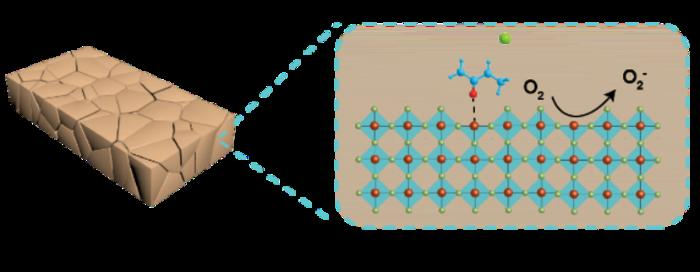Tin perovskites have garnered significant attention in the development of lead-free perovskite solar cells.
 Schematic illustration of the effects of SEM-HCl additive on the tin perovskites. Image Credit: Wenbo Jia, Yi Jing, Han Zhang, Baoyan Tian, Huabo Huang, Changlei Wang, Ligang Xu
Schematic illustration of the effects of SEM-HCl additive on the tin perovskites. Image Credit: Wenbo Jia, Yi Jing, Han Zhang, Baoyan Tian, Huabo Huang, Changlei Wang, Ligang Xu
However, deep-level traps caused by Sn vacancies and undercoordinated Sn ions on the tin perovskite surfaces can impede further device stability and efficiency by causing non-radiative recombination and the absorption of nucleophilic O2 molecules.
At Nanjing University of Posts & Telecommunications in China, researchers under the direction of Prof. Ligang Xu are interested in lead-free perovskite solar cells because deep-level traps in these cells reduce their stability and efficiency.
Initially, the tin perovskite precursor was treated with semicarbazide hydrochloride (SEM-HCl) to produce high-quality perovskite films with a low concentration of deep-level traps. The SEM-HCl modifies the intrinsic Sn deep-level defects in addition to reducing the amount of uncoordinated Sn2+ on the surface.
The result of such thorough modulation is improved device performance. The coordination interactions between the O=C-N functional group in SEM-HCl and the charge defects in tin perovskites can increase the electron cloud density surrounding the defects and increase the energy required for vacancy formation.
Most importantly, this method contributes to decreasing the deep-level trap state density, which results from undercoordinated Sn2+ ions and Sn4+ oxidation.
This decreases nonradiative recombination and increases the charge lifetime. As a result, the TPSCs attain a champion PCE of about 11% with notable working stability. After operating for 100 hours under AM1.5 illumination, the unencapsulated device retains nearly 100% of its initial efficiencies.
Journal Reference:
Jia, W., et al. (2023) Suppression of deep-level traps via semicarbazide hydrochloride additives for high-performance tin-based perovskite solar cells. Frontiers of Optoelectronics. doi.org/10.1007/s12200-023-00103-1